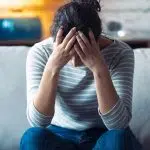A (non-exhaustive) list of strategies:
“Anxiety is the dizziness of freedom” – Soren Kierkegaard
- Controlled diaphragmatic breathing
As we discussed above, anxiety can show itself through physical symptoms and a major aspect of that is shortness of breath. It’s very common when someone becomes anxious for changes to occur in their breathing. They can begin to gulp air, thinking that they are going to suffocate, or can begin to breathe really quickly. This has the effect of making them feel dizzy and therefore more anxious. This is called over-breathing, or hyperventilation [1]. The first step in combating this is knowing that it happens. Next, knowing when it happens, you should mindfully slow down your breathing and use your stomach to do the work… imagine your abdomen as the pump and focus on pushing it. Take longer to breathe out than breathing in – say, breathe in for 4 seconds and breathe out for 5. A way to think about it is following a rectangle:
2. Exercise
Exercise is branded as the ‘wonder pill’, being the treatment for a wide range of ailments and rightly so! Not only can exercise reverse the potential physical complications of anxiety caused by a lack of physical activity, it can also help to alleviate anxiety. This makes sense when you think about it – it distracts your mind from external worries when all it is concerned about is keeping your heart pumping blood to your muscles and brain. Research shows aerobic exercise is especially helpful. A simple bike ride, dance class, or even a brisk walk can be a powerful tool for those suffering from chronic anxiety [2]. Why is this the case? It turns out physical activity physically changes your brain by increasing the availability of important anti-anxiety neurochemicals, including serotonin, gamma aminobutyric acid (GABA), brain-derived neurotrophic factor (BDNF), and endocannabinoids [3].
Exercise also works to calm the part of the brain intimately involved with fear, called the amygdala, by activating the ‘rational’ and more newly evolved area of the brain called the prefrontal cortex [4].
3. Use your five senses
What are the five senses? These are the senses of smell, hearing, seeing, tasting and feeling. Using the five senses is a commonly used technique to trick the brain into a restful state [5] – away from the heightened sense of the surroundings and rushing thoughts. The “5-4-3-2-1” grounding method incorporates this and is simple [6]:
- 5 things you can SEE: Your hands, the sky, a plant on your colleague’s desk
- 4 things you can physically FEEL: Your feet on the ground, a ball, your friend’s hand
- 3 things you can HEAR: The wind blowing, children’s laughter, your breath
- 2 things you can SMELL: Fresh-cut grass, coffee, soap
- 1 thing you can TASTE: A mint, gum, the fresh air
It works the same way mindfulness does, so if you’re looking for a similarly effective but easier to follow method then you might find this useful.

SUMMARY
Anxiety is like fear, but it’s harder to understand and control when you’re not aware of how it works and some easy ways to calm it down. There are plenty of ways to address anxiety and the list above is not exhaustive by any means.
It’s important to know that you’re not alone – 1 in 4 people will experience a mental health problem of some kind each year in England and 1 in 6 people report experiencing a common mental health problem (like anxiety and depression) in any given week in England [7]
Ultimately, the best treatment is therapy from a healthcare professional in this field. If you feel like your anxiety is out of control and believe you need a referral to a therapist or psychiatrist, the easiest way to do this is to contact one of our GPs who can guide you to the best person for the job.
To seek more help and advice please book an anxiety appointment with one of our GPs today.
References:
[1] https://web.ntw.nhs.uk/selfhelp/leaflets/Anxiety.pdf [2] https://www.health.harvard.edu/blog/can-exercise-help-treat-anxiety-2019102418096 [3] https://pubmed.ncbi.nlm.nih.gov/28319590/ [4] https://www.jneurosci.org/content/33/18/7770 [5] https://onlinelibrary.wiley.com/doi/abs/10.1111/nicc.12198 [6] https://www.mayoclinichealthsystem.org/hometown-health/speaking-of-health/5-4-3-2-1-countdown-to-make-anxiety-blast-off [7] https://www.mind.org.uk/information-support/types-of-mental-health-problems/statistics-and-facts-about-mental-health/how-common-are-mental-health-problems/


